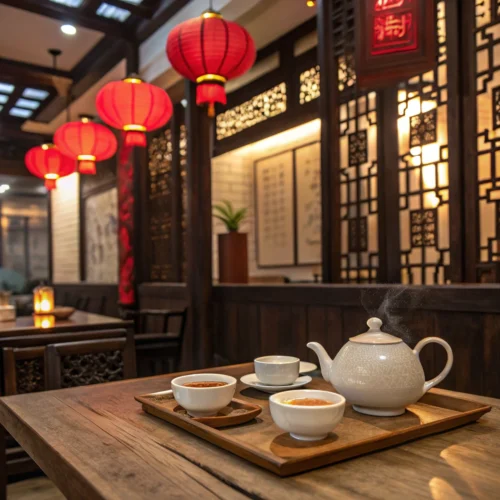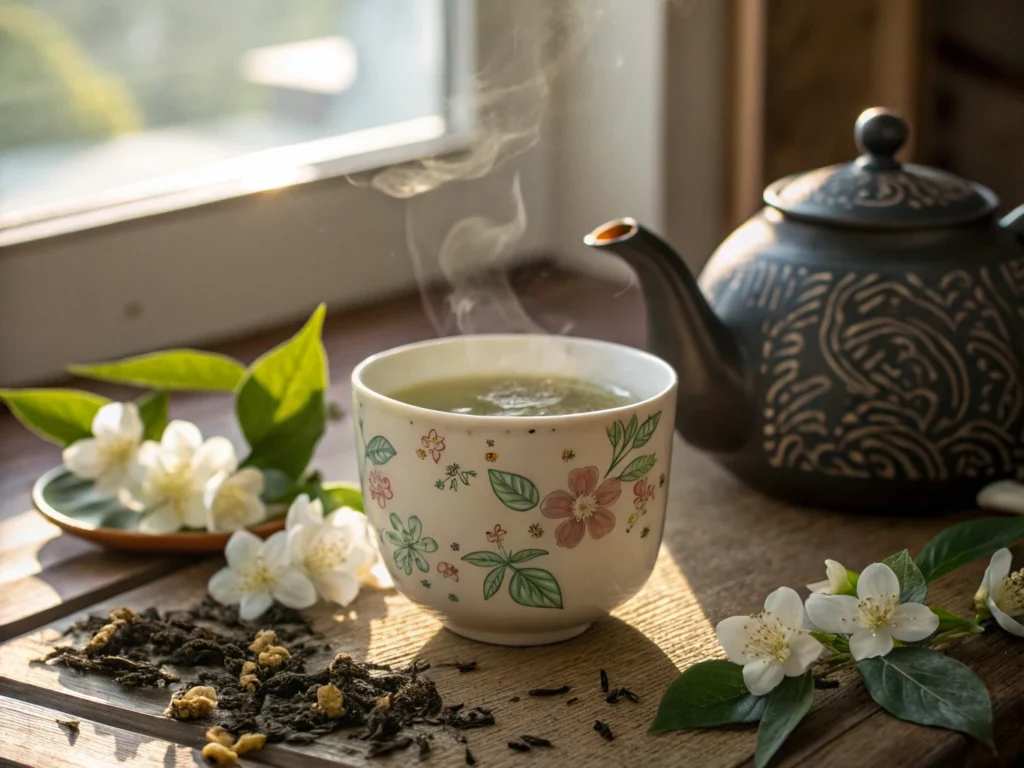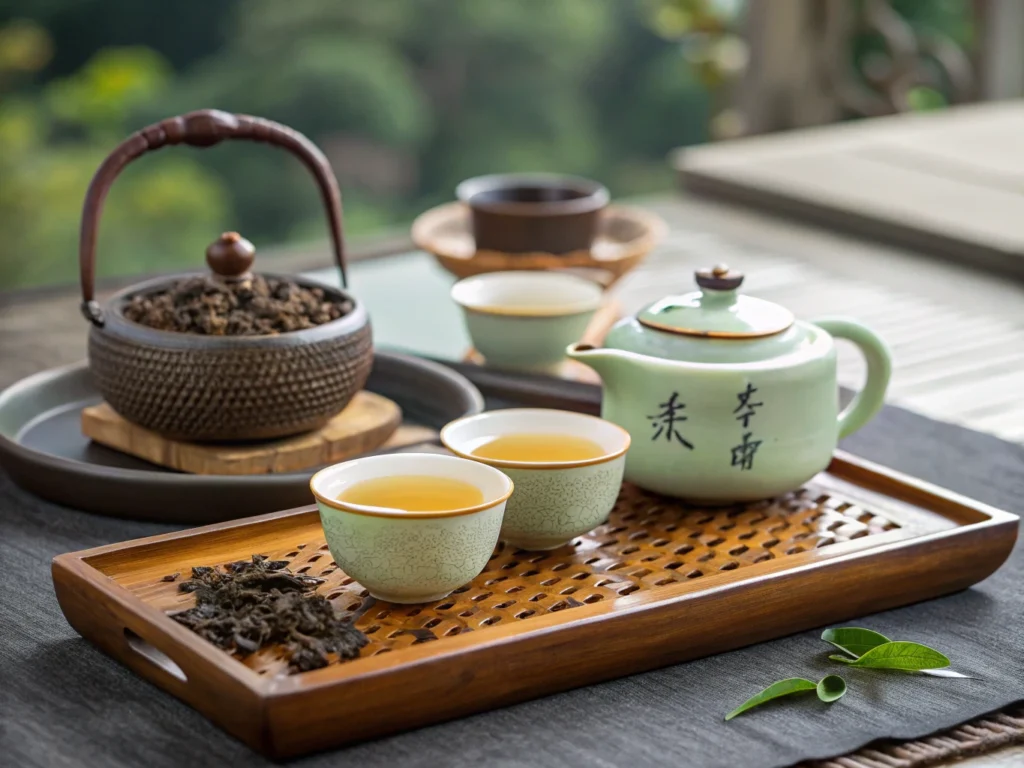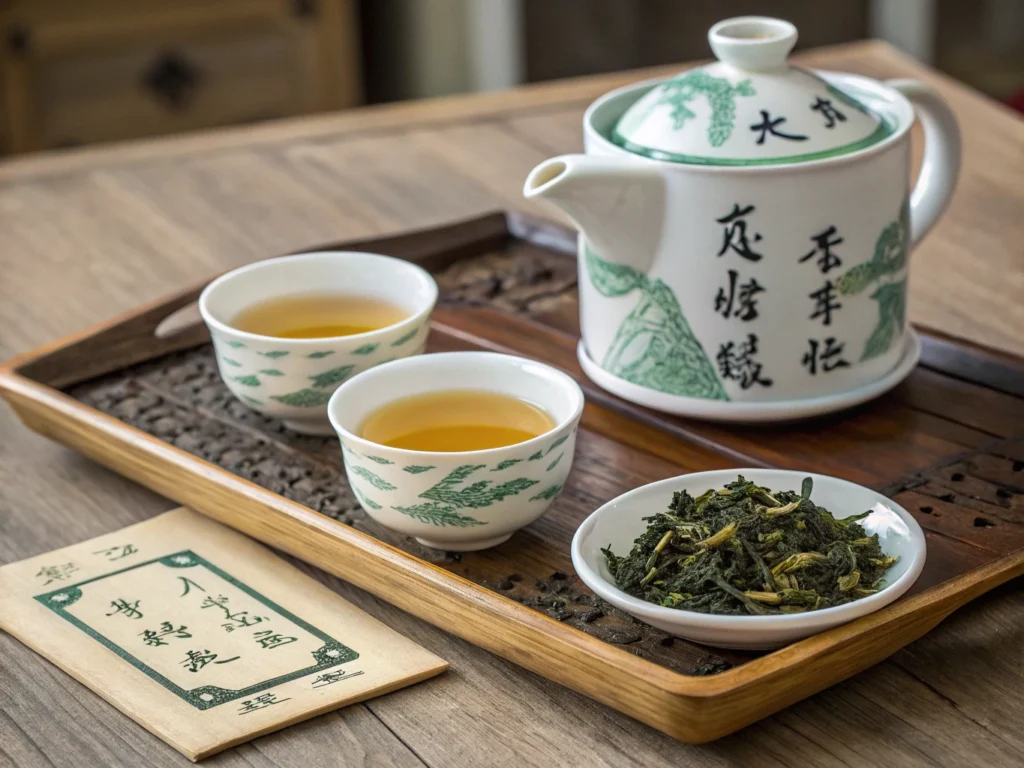
ANNONCE
Table of Contents
ANNONCE

Tea Used in Chinese Restaurants
Ingredients
- Jasmine Tea
- Oolong Tea
- Pu-erh Tea
- Green Tea
- Black Tea
Instructions
- Jasmine tea is often served with lighter dishes such as dim sum, providing a delicate floral aroma that cleanses the palate.
- Oolong tea pairs well with heartier dishes, such as roasted meats or spicy stir-fries, thanks to its balanced flavor profile.
- Pu-erh tea is commonly served after meals to aid digestion, particularly after heavy or fatty dishes.
- Green tea is frequently paired with lighter dishes like vegetable stir-fries or steamed fish to complement their fresh, grassy flavors.
- Black tea is often used to accompany rich, substantial dishes, cutting through the richness with its strong and bold flavor.
Notes
What is the Tea Used in Chinese Restaurants?
When I was younger, I spent many afternoons at my Aunt Mei’s house. After school, my cousins and I would gather around the small wooden table in the kitchen while Aunt Mei brewed a fresh pot of tea. The aroma filled the room, a calming scent that was somehow both invigorating and soothing. As I grew older, I realized that the tea served at Aunt Mei’s house was not just any tea—it was a part of a deep and rich cultural tradition. This memory, steeped in the fragrant tea that my family shared, sparked my curiosity about the role of tea in Chinese culture, especially in restaurants.
Chinese tea, particularly the tea served in restaurants, is far more than just a drink—it is a symbol of hospitality, tradition, and taste. As I began researching, I discovered the vast variety of teas used in Chinese dining establishments and their importance in creating the perfect dining experience. In this article, I will explore the different types of tea commonly used in Chinese restaurants, their significance, and why certain varieties are chosen.

The Importance of Tea in Chinese Culture
Tea has been integral to Chinese culture for over two thousand years. In fact, it is considered the national drink, representing hospitality, respect, and the value placed on simplicity. The process of making tea is deeply intertwined with Chinese philosophy, reflecting the balance of nature and life. Tea ceremonies, for instance, are a reflection of China’s emphasis on mindfulness and ritual in daily life.
ANNONCE
In the context of Chinese restaurants, tea is not merely a beverage—it serves as a gesture of respect towards guests, as well as a way to enhance the dining experience. The tea you are served is chosen not only for its flavor but also for its role in balancing the meal. Whether it’s a light and refreshing green tea or a rich, earthy pu-erh tea, the tea complements the dishes served, providing a sense of harmony between the food and drink.
The Role of Tea in Chinese Restaurants
The role of tea in Chinese restaurants extends far beyond that of a mere refreshment. For many Chinese restaurants, the act of offering tea to guests is a symbol of hospitality. It serves to cleanse the palate and prepare the taste buds for the flavors to come. In Chinese culture, offering tea to guests is seen as a gesture of respect and a way to create a warm, welcoming atmosphere.
Moreover, the tea served in Chinese restaurants is often selected to match the type of cuisine being enjoyed. For example, while lighter teas like jasmine or green tea pair well with delicate dishes such as dim sum, richer teas like oolong or pu-erh are often paired with heavier meats and spicy dishes. This careful selection of tea enhances the overall dining experience, ensuring that the flavors of the food and tea work together to create a harmonious balance.
Types of Tea Commonly Used in Chinese Restaurants
When it comes to tea, Chinese restaurants typically offer a variety of options. The selection of tea can vary depending on the region, the restaurant’s style, and the preferences of the clientele. Here, I will delve into some of the most commonly served teas in Chinese restaurants.
ANNONCE
Jasmine Tea: The Fragrant Favorite
Jasmine tea is perhaps the most iconic tea served in Chinese restaurants. Known for its fragrant aroma, jasmine tea is made by infusing green tea leaves with jasmine flowers. The result is a tea that is both delicate and aromatic, with a floral fragrance that lingers long after the tea is brewed. Jasmine tea is often served in Chinese restaurants as it pairs well with a variety of dishes, especially lighter fare such as dim sum.
The sweetness of jasmine tea complements the delicate flavors of seafood and vegetables, making it a popular choice in many Chinese restaurants. Its floral notes can also help to cleanse the palate between bites, enhancing the overall dining experience.
Oolong Tea: A Balancing Act of Flavors
Oolong tea strikes a balance between the boldness of black tea and the lightness of green tea. It is made from the leaves of the Camellia sinensis plant, the same plant used for green and black tea, but undergoes a unique processing method that allows the leaves to partially ferment. This results in a tea that has a complex flavor profile, with notes that can range from sweet and floral to rich and woody.
Oolong tea is commonly served in Chinese restaurants alongside heartier dishes, such as roasted meats or spicy stir-fries. Its robust flavor and ability to cleanse the palate make it a versatile choice, complementing a wide range of flavors. In addition, oolong tea is often enjoyed during long meals, where its refreshing qualities help to balance the richness of the food.
ANNONCE
Pu-erh Tea: A Distinctive Post-Meal Drink
Pu-erh tea is a unique and distinctive tea that is typically served after meals in Chinese restaurants. Originating from the Yunnan province in southwestern China, pu-erh tea undergoes a fermentation process that gives it a deep, earthy flavor. It is often described as having a rich, robust taste with a slightly woody or musty quality.
Pu-erh tea is believed to aid digestion, which is why it is often served after a heavy meal. Its earthy flavor is thought to help cleanse the stomach and neutralize the richness of fatty or spicy foods. For this reason, many Chinese restaurants offer pu-erh tea as a digestive aid after a large meal.
Green Tea: The Refreshing Classic
Green tea is one of the most popular and widely consumed teas in China. It is made from unoxidized tea leaves, which allows it to retain its natural green color and fresh, grassy flavor. Green tea is often considered a healthier option, as it is rich in antioxidants and has been linked to a variety of health benefits.
In Chinese restaurants, green tea is commonly served as an accompaniment to light dishes such as vegetable stir-fries, steamed fish, or tofu. Its refreshing taste makes it an excellent choice for cleansing the palate, and its subtle flavor does not overpower the more delicate flavors of the food.
ANNONCE
Black Tea: Strong and Bold
While black tea is not as commonly served in Chinese restaurants as other types, it can still be found in certain establishments. Black tea is fully oxidized, which gives it a strong, bold flavor with malty, sweet, or astringent notes. In Chinese restaurants, black tea is often paired with richer, more substantial dishes, such as braised meats or spicy foods.
The robust flavor of black tea makes it an ideal choice for cutting through the richness of fatty dishes, providing a refreshing contrast that enhances the overall dining experience.

Tea Selections for Specific Chinese Dishes
In Chinese cuisine, the selection of tea is often tailored to complement specific dishes. Pairing the right tea with the right dish can enhance the flavors and create a more harmonious dining experience. Here, I will explore some common pairings.
Pairing Tea with Dim Sum
Dim sum is a beloved Chinese culinary tradition that consists of small, bite-sized dishes served in steamer baskets or on small plates. Because dim sum encompasses a wide range of flavors, from delicate dumplings to savory buns, a variety of teas are often served to complement the meal. Jasmine tea is a popular choice for dim sum, as its floral notes enhance the lightness of the dishes without overpowering their flavors. Oolong tea is also a great option, as its balanced flavor profile works well with both savory and sweet dim sum options.
ANNONCE
Tea for Cantonese Cuisine
Cantonese cuisine is known for its emphasis on fresh ingredients and delicate flavors. Dishes such as steamed fish, stir-fried vegetables, and dim sum are commonly found in Cantonese restaurants. For these lighter dishes, green tea is often the tea of choice. Its refreshing, slightly grassy flavor complements the fresh ingredients used in Cantonese cooking and helps cleanse the palate between bites.
Tea for Hot Pot
Hot pot is a popular communal dining experience where diners cook their own food in a simmering pot of broth. The rich and often spicy flavors of hot pot require a tea that can cleanse the palate and balance the intensity of the broth. Oolong tea is a great choice, as its complex flavor profile can stand up to the bold flavors of hot pot. Additionally, pu-erh tea is often served after hot pot to aid in digestion and help neutralize the heaviness of the meal.
Tea with Seafood
Seafood dishes, such as steamed fish or stir-fried shrimp, are a staple in Chinese cuisine. The delicate flavors of seafood pair well with lighter teas, such as jasmine or green tea. The floral notes of jasmine tea complement the sweetness of the seafood, while the grassy flavor of green tea enhances the freshness of the fish.
The Tea Serving Process in Chinese Restaurants
Tea is served in a specific manner in Chinese restaurants, following traditional customs and etiquette. Understanding the tea-serving process can provide valuable insight into Chinese dining culture.
ANNONCE
Traditional Tea Ceremony in Chinese Restaurants
In some high-end Chinese restaurants, the tea service may involve a formal tea ceremony. This ceremony is a ritualistic process where the tea leaves are carefully measured, the water is heated to the correct temperature, and the tea is brewed in a specific manner. The process is done with great precision and respect, as the tea is considered a key part of the dining experience.
How Tea is Served: Etiquette and Customs
In Chinese restaurants, tea is often served in small cups, and it is customary for the server to pour tea for the guests. When receiving tea, it is polite to lightly tap the table with your fingers as a sign of gratitude. This gesture is a tradition that dates back to ancient China, where it was used to show respect to the server.
What Type of Tea Do Chinese Restaurants Use?
Chinese restaurants use a variety of teas to suit different tastes and preferences. The types of tea offered may vary depending on the region, the style of the restaurant, and the specific dishes being served. Some of the most common teas include jasmine tea, oolong tea, green tea, pu-erh tea, and black tea.
Overview of Most Popular Teas in Chinese Restaurants
The most popular teas in Chinese restaurants are typically those that offer a balance of flavor and aroma. Jasmine tea is often the go-to choice for lighter dishes, while oolong tea is favored for its versatility. Pu-erh tea is widely enjoyed after meals, while green tea is a staple in many Chinese restaurants due to its health benefits and refreshing taste.
ANNONCE
Why Chinese Restaurants Choose Certain Types of Tea
Chinese restaurants choose specific types of tea based on a variety of factors, including flavor, tradition, and the dishes being served. For example, lighter teas like jasmine and green tea are often paired with delicate dishes, while stronger teas like oolong and pu-erh are chosen for heavier meals. The choice of tea is also influenced by regional preferences and the restaurant’s overall concept.

What Tea Do Chinese People Drink After Dinner?
In China, tea is often consumed after meals as a digestive aid. This practice has been passed down for centuries and is believed to help with digestion and cleanse the body.
Common Post-Meal Tea Options
Pu-erh tea is the most common tea served after meals in China. Its earthy flavor and ability to aid in digestion make it the perfect post-meal beverage. Other teas, such as oolong and green tea, are also sometimes consumed after meals, depending on personal preference.
Health Benefits of Drinking Tea After Meals
Drinking tea after meals has numerous health benefits. It is believed to help with digestion, reduce bloating, and aid in the absorption of nutrients. Certain types of tea, such as pu-erh, are also thought to have detoxifying properties that can help cleanse the body after a heavy meal.
ANNONCE
What Brand of Tea Do Restaurants Use?
Chinese restaurants typically use high-quality tea leaves to ensure that the tea served is both flavorful and aromatic. The choice of tea brand varies from restaurant to restaurant, with some establishments sourcing their tea from well-known brands, while others may work directly with tea suppliers.
Popular Brands in Chinese Restaurants
Some popular tea brands in Chinese restaurants include Twinings, Teavana, and Lipton. However, many high-end Chinese restaurants may also offer premium, loose-leaf teas sourced directly from China.
How Restaurants Select Their Tea Brands
Restaurants select their tea brands based on factors such as flavor, quality, and cost. Some restaurants may prioritize premium teas, while others may opt for more affordable options. Additionally, the type of tea served may depend on the restaurant’s clientele and the dishes on the menu.
What is a Traditional Chinese Tea Set Called?
A traditional Chinese tea set is an essential part of tea culture. It consists of various pieces designed specifically for brewing and serving tea.
ANNONCE
Elements of a Traditional Chinese Tea Set
A traditional Chinese tea set typically includes a teapot, tea cups, a tea tray, and tools such as a tea strainer and tea tongs. The teapot is often made of clay or porcelain, and the cups are small and delicate.
The History and Symbolism of Tea Sets in China
The Chinese tea set has a long history and is often seen as a symbol of respect and hospitality. The act of serving tea from a traditional tea set is a deeply ingrained cultural practice, symbolizing the warmth and generosity of the host.
The Famous Teas of China
China is known for producing some of the best teas in the world. From the delicate leaves of Jasmine Tea to the earthy flavors of Pu-erh, the country offers a wide variety of teas that are cherished both locally and internationally.
The Top Teas Produced in China
Some of the most famous teas produced in China include Longjing (Dragon Well), Tie Guan Yin, Jasmine Tea, and Pu-erh Tea. These teas are highly sought after for their exceptional quality and unique flavors.
ANNONCE
The Cultural Significance of Famous Chinese Teas
Famous Chinese teas are not only prized for their flavor but also for their cultural significance. Each tea has its own story, tied to specific regions and traditions. For example, Longjing tea is considered a symbol of Chinese hospitality and is often gifted to guests as a sign of respect.
Frequently Asked Questions (FAQs)
What type of tea do Chinese restaurants use?
Chinese restaurants often serve a variety of teas, with jasmine, oolong, and green tea being the most common. Pu-erh tea is also popular as a post-meal drink.
What tea is used in Chinese tea?
Chinese tea includes a wide range of varieties, including jasmine tea, oolong tea, pu-erh tea, green tea, and black tea.
What brand of tea do restaurants use?
Many Chinese restaurants use premium tea brands, such as Twinings, Teavana, or local Chinese suppliers, to provide high-quality tea options for customers.
ANNONCE
What tea do Chinese drink after dinner?
After dinner, Chinese people commonly drink pu-erh tea for its digestive benefits. Oolong and green teas are also occasionally consumed.
What is a traditional Chinese tea set called?
A traditional Chinese tea set is simply referred to as a “Chinese tea set.” It typically includes a teapot, tea cups, and other tea accessories used for serving tea.
What is the famous tea in China?
Some of the most famous teas in China include Longjing (Dragon Well), Tie Guan Yin, and Pu-erh. These teas are renowned for their exceptional quality and flavor.

